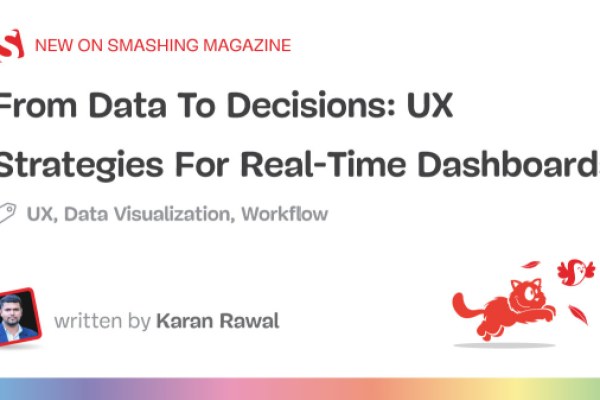
Magazine

The Psychology Of Trust In AI: A Guide To Measuring And Designing For User Confidence — Smashing Magazine
When AI “hallucinates,” it’s more than just a glitch — it’s a collapse of trust. As generative AI becomes part of more digital products, trust has become the invisible user interface. But trust isn’t mystical. It can be understood, measured, and designed for. Here is a practical guide for designing more trustworthy and ethical AI…

SerpApi: A Complete API For Fetching Search Engine Data — Smashing Magazine
From competitive SEO research and monitoring prices to training AI and parsing local geographic data, real-time search results power smarter apps. Tools like SerpApi make it easy to pull, customize, and integrate this data directly into your app or website. SerpApi leverages the power of search engine giants, like Google, DuckDuckGo, Baidu, and more, to…

From Data To Decisions: UX Strategies For Real-Time Dashboards — Smashing Magazine
Real-time dashboards are decision assistants, not passive displays. In environments like fleet management, healthcare, and operations, the cost of a delay or misstep is high. Karan Rawal explores strategic UX patterns that shorten time-to-decision, reduce cognitive overload, and make live systems trustworthy. I once worked with a fleet operations team that monitored dozens of vehicles…

Designing For TV: Principles, Patterns And Practical Guidance (Part 2) — Smashing Magazine
After covering in detail the underlying interaction paradigms of TV experiences in Part 1, it’s time to get practical. In the second part of the series, you’ll explore the building blocks of the “10-foot experience” and how to best utilise them in your designs. Having covered the developmental history and legacy of TV in Part…

A Breeze Of Inspiration In September (2025 Wallpapers Edition) — Smashing Magazine
Could there be a better way to welcome the new month than with a new collection of desktop wallpapers? We’ve got some eye-catching designs to make your September just a bit more colorful. Enjoy! September is just around the corner, and that means it’s time for some new wallpapers! For more than 14 years already,…

Designing For TV: The Evergreen Pattern That Shapes TV Experiences — Smashing Magazine
TV interface design is a unique, fascinating, and often overlooked field. It’s been guided by decades of evolution and innovation, yet still firmly constrained by its legacy. Follow Milan into the history, quirks, and unshakable rules that dictate how we control these devices. Television sets have been the staple of our living rooms for decades….

A Week In The Life Of An AI-Augmented Designer — Smashing Magazine
If you are new to using AI in design or curious about integrating AI into your UX process without losing your human touch, this article offers a grounded, day-by-day look at introducing AI into your design workflow. Artificial Intelligence isn’t new, but in November 2022, something changed. The launch of ChatGPT brought AI out of…

Beyond The Hype: What AI Can Really Do For Product Design — Smashing Magazine
AI tools are improving fast, but it’s still not clear how they fit into a real product design workflow. Nikita Samutin walks through four core stages — from analytics and ideation to prototyping and visual design — to show where AI fits and where it doesn’t, illustrated with real-world examples. These days, it’s easy to…

From Line To Layout: How Past Experiences Shape Your Design Career — Smashing Magazine
Your past shapes who you are as a designer, no matter where your career began or how unexpected your career path may have been. Stephanie Campbell shows how those lessons can sharpen your instincts, strengthen collaboration, and help you become a better designer today. Learn how the skills you have learned in your previous jobs…

The Power Of The Intl API: A Definitive Guide To Browser-Native Internationalization — Smashing Magazine
Internationalization isn’t just translation. It’s about formatting dates, pluralizing words, sorting names, and more, all according to specific locales. Instead of relying on heavy third-party libraries, modern JavaScript offers the Intl API — a powerful, native way to handle i18n. A quiet reminder that the web truly is worldwide. It’s a common misconception that internationalization…



